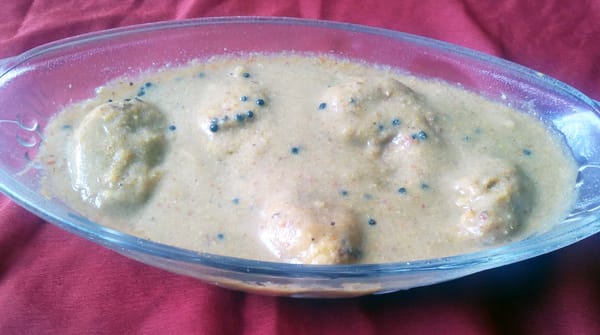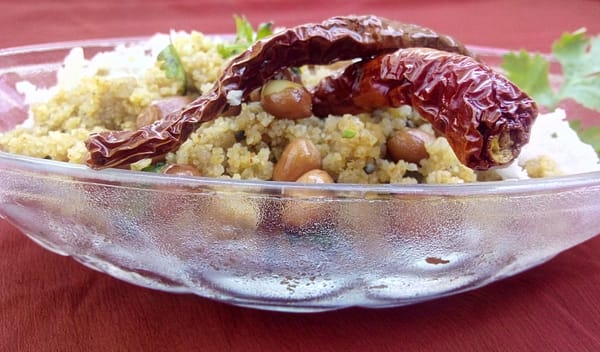Bangalore has everything at your service; local goods, imported commodities, native touch, embedded culture and what not! From Yoga to Kung-fu, from Desi to Gucci, Bangalore prides over having everything to offer to its residents.
We have international and interstate exotic dishes available throughout the city. But wait, is there any recipe that is rarely available in Bangalore? Yes, we found many. There are our own Karnataka recipes that most of our restaurants don’t serve. We have listed ten of them here.
So, for all the foodies out there, here is a list of ten such delicacies found not so easily in Bangalore.
Kuchida Kadabu
Malenadu predominantly includes portions of Chikkamagaluru, Shimoga and Uttara Kannada districts. Blessed with the beauty of nature, it offers so much in its culinary that goes way beyond expectations. One of them is Kuchida Kadubu. This is a popular recipe prepared during Nagara Panchami festival.
How to prepare: Rice and Poha (beaten rice) are soaked and ground to form a thick batter. This batter is boiled in a heavy vessel at a low flame, with continuous stirring to make a dough. A sweet filling is prepared out of grated Coconut, powdered Jaggery, and Cardamom, whereas a spicy filling is prepared out of soaked black gram(Urad dal), curry leaves, coriander leaves, ginger and chilies. The dough is pressed on banana leaf with sweet/spicy filling inside and steamed. This tastes good with a generous quantity of ghee!
Banana Fritters (Baale Muruku)
This irresistible confection is a signature snack of Coorg.
How to prepare: Ripe bananas are mixed with jaggery, cardamom, sesame seeds and all-purpose flour and are deep-fried. These luscious amusements are slightly crunchy on the outside, and buttery soft on the inside, making it a favorite amongst children and adults alike. Have them with a strong black coffee of Coorg and you will never want to stop!
Sandige Huli or Unde Huli
This is a protein-packed enticing delicacy of Bangalore/Mysore/Malenadu regions, made mostly during festivals.

Undehuli / lentil ball curry. Pic: Sowrabha Karinje
How to prepare: Soaked Pigeon peas (Toor dal) and Bengal gram (Chana Dal) are ground along with spices to make small balls. These balls are steamed and/or fried. The huli(gravy) is made using dal water, Rasam powder, tamarind, jaggery etc. A simple tempering of mustard, curry leaves and asafoetida in oil makes it heavenly. The Sandige/Unde/lentil balls are added to the gravy instead of vegetables. This tastes best when served with rice and a dollop of ghee.
Holige Saaru
This side dish is made during Ugadi festival and holds a special place in the hearts of Kannadigas for the memories that it brings along.
How to prepare: The filling (generally the leftover after making Holige/Obbattu; hence the name) majorly comprises of Pigeon peas (Toor dal), jaggery, coconut and cardamom. This filling is diluted with water, and an addition of spices along with coconut and tamarind makes this Holige saaru. Served with plain hot rice and fries.
Saasive
This literally means mustard. The name might have been derived because mustard is the standing-out ingredient of this side dish.
How to prepare: This is made using a wide variety of ingredients. Fruit or vegetable like pineapple/beetroot is boiled with jaggery and salt. If chosen to make with ripe mango, boiling can be avoided. Coconut, mustard and green chillies are ground and added to the the boiled fruit or vegetable. This is a simple but a lip-smacking dish for a lazy day. Goes well with plain rice.
Honagone Soppu Palya (stir fry)
This is a local Karnataka speciality, made of Honagone Soppu (Sessile Joyweed). This herb has several medicinal properties, as well as an inviting taste.
How to prepare: Honagone leaves are stir-fried with spices, onion, garlic and lentils to make this side dish. This is served with rice or chapathi. This dish is often found at traditional-cooking homes of Bangalore, but rarely makes it to the restaurants, thus making it an unknown food for the global community of Bangalore.
Gojjavalakki
This is a simple and easy recipe that once tasted, marks a permanent place in your snacks list.

Gojjavalakki (Poha sweet-sour upma). Pic: Sowrabha Karinje
How to prepare: The thicker variety of beaten rice (Poha) is crushed in a blender. A mixture of tamarind, jaggery, salt and Rasam powder in water is prepared. This spicy water is poured on the crushed Poha and let to soak for 15-20 minutes. A tempering of spices along with peanuts makes this a yummy breakfast/snack.
Gorikai Matawadi Palya (Clusterbeans and lenthil stir fry)
This is a traditional recipe of Karnataka, made with Cluster beans and lentils. Cluster beans have a slightly bitter taste, but are highly nutritious. And this stir fry recipe makes the bitterness immaterial.
How to prepare: Soaked Bengal gram (Chana Dal) is ground with red or chillies, asafoetida
and coconut into a coarse mixture. Cluster beans are half cooked, and then the ground mixture is added. Cooking is continued till the cluster beans are done. This tastes best with hot rotis or rice.
Methi (Fenugreek) leaves Chitranna
Every south Indian restaurant serves Chitranna (lemon rice), but a refreshing Fenugreek leaves-touch to it adds a definitely drool-worthy twist to the recipe.
How to prepare: First tempering is done with spices and herbs, and peanuts are added to it. Later on, capsicum, fenugreek leaves and green chillies are added. Once the leaves are wilted, Cumin and Coriander powders are added. Cooked rice is added to this. Then comes the lemon juice which balances off the bitter taste in Fenugreek leaves. Garnishing is done with coriander leaves and coconut.
Hurulikaalu Dosa/Horse gram Dosa
Horse gram is a reddish brown legume, rich in nutrients like protein, fiber and vitamin B-complex to name a few. Making a dosa out of this is a real healthy and tasty option.
How to prepare: Rice, small quantity of black gram (Urad dal) and fenugreek are soaked, ground and fermented. Soaked horse gram is ground into a paste and added to this. Dosa prepared with this batter can be served with any chutney.
The list doesn’t end here; this is just an introduction to the long list of recipes that Karnataka has to offer. So people, that was a peek into the recipes that you find rarely in hotels!
Update:
Gojjavalakki is available at Iyer Tiffin Center on Mount Joy Road in Hanumanthnagar, close to the petrol bunk on 50 feet road.
Tell us if you know of any restaurant that serves any of these, we will add them to the article.
Related Articles
Organic food taking hold, though prices are higher
God’s own food in Namma Ooru!
MTR: the tiffin room Bengaluru will cherish forever
Gojju avalakki is available at Iyer Tiffin Center on Mount Joy Road in Hanumanthnagar. It is close to the petrol bunk on 50 feet road.
Thanks for the info. We will add it to the article.
good. very useful. will you please post the recipe for ‘ sakkare holige’.